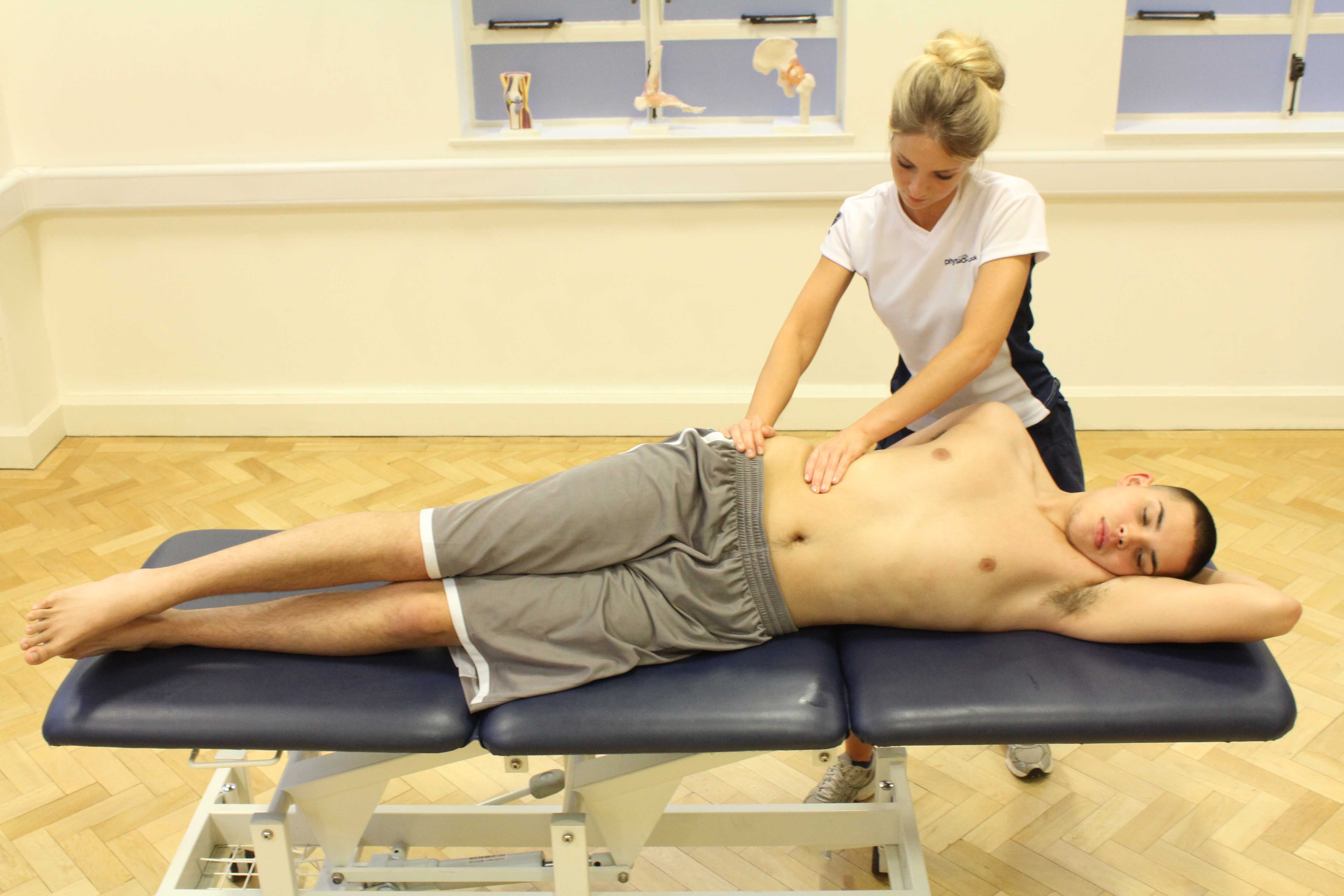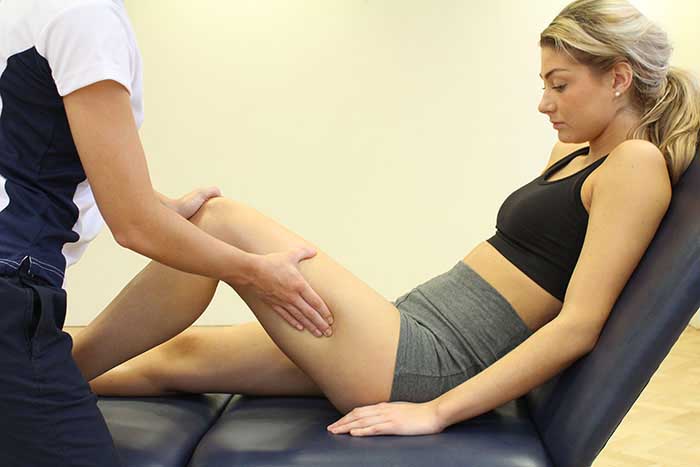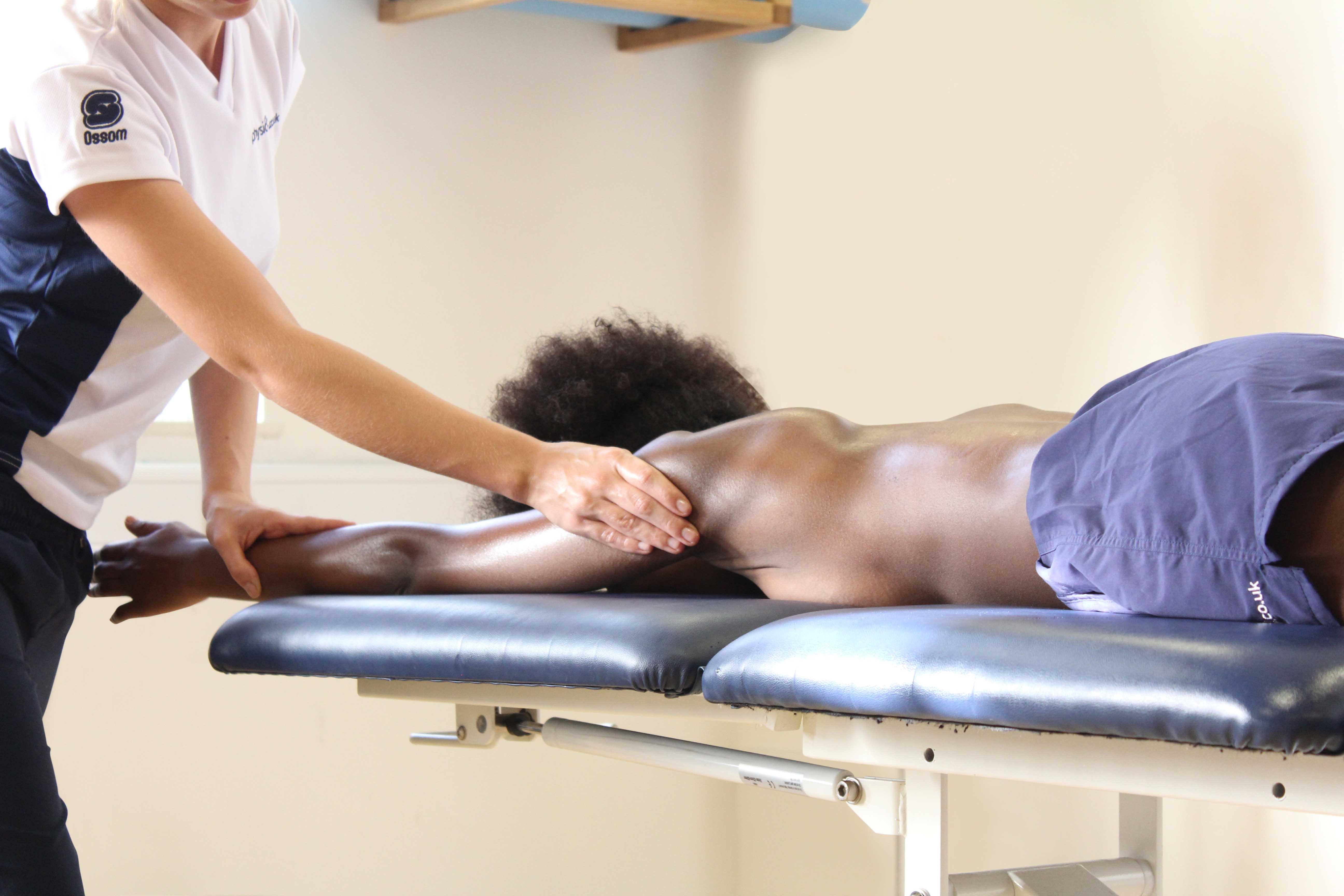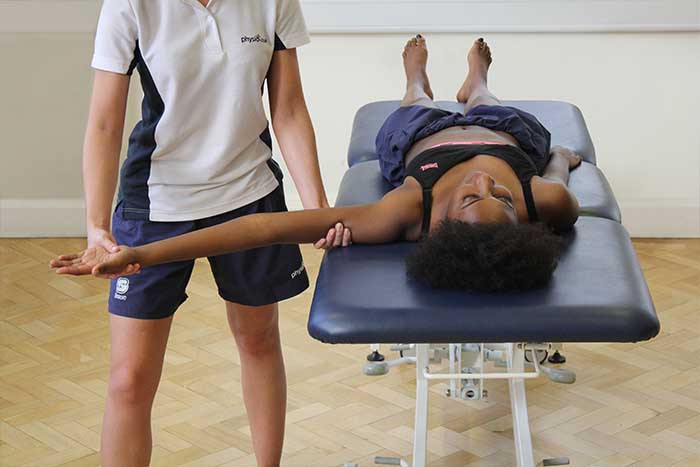A massage can help reduce delayed onset muscle soreness. Delayed onset muscle soreness occurs after intense training or exercise. The pain produced in delayed onset muscle soreness can be caused by a build-up of tension within muscles, a build-up of metabolic wastes or small, microscopic tears in muscle fibres caused by overuse of the muscle. Delayed onset muscle soreness increases pain and stress levels within a person, preventing relaxation. Our massage therapists at Physio.co.uk reduce delayed onset muscle soreness through massage to help a person return to sport or exercise more quickly.
What are the most appropriate types of massage to reduce delayed onset muscle soreness?
A variety of massage types can be used to reduce delayed onset muscle soreness. The most common types of massage used include:
 Above: Soft tissue massage of abdominal oblique muscle
Above: Soft tissue massage of abdominal oblique muscleThe massage types most commonly used to reduce delayed onset muscle soreness include deep tissue massage, sports massage and Swedish massage.
A deep tissue massage can help reduce delayed onset muscle soreness. A deep tissue massage focuses on deep soft tissues within the body. A deep tissue massage aims to flush out metabolic wastes that have built up within the muscles, causing delayed onset muscle soreness. The flushing out of metabolic wastes occurs due to the deep tissue massage stimulating an increase in lymphatic flow. Increasing lymphatic flow, increases the rate of metabolic wastes being removed from the body and therefore reduces muscular ache and pain.

Delayed onset muscle soreness can be reduced through sports massage. A sports massage is effective for encouraging the healing of microscopic tears in muscle fibres. Delayed onset muscle soreness can cause the treatment area to be tender to touch so pressure used throughout a sports massage varies dependent on pain levels. A sports massage improves the circulation of blood. Oxygen and nutrients are carried within the blood flow. Oxygen and nutrients are used for the repair of damaged tissues and fibres and also to give a muscle an increase in energy. Increasing blood flow, increases the repair of the torn muscle fibres. Increasing repair of torn muscle fibres, decreases pain and therefore delayed onset muscle soreness.
A Swedish massage is often used to reduce delayed onset muscle soreness. A Swedish massage encourages the removal of waste products and toxins whilst also increasing relaxation. During and after intense exercise or activity, a build-up of tension as well as waste products occurs within muscles. A build-up of tension causes muscles to stay in the state of contraction, reducing relaxation, increasing pain and restricting movement. A build-up of waste products results in muscle fatigue and weakness. A Swedish massage helps to relieve tension to allow muscles to relax and pain to decrease. A Swedish massage also stimulates the lymphatic system which is responsible for the removal of waste products and toxins. The removal of waste products and toxins reduces muscular fatigue and weakness. Increasing relaxation and decreasing fatigue and weakness contribute to reducing delayed onset muscle soreness.
What techniques are used to reduce delayed onset muscle soreness?
There are a wide range of techniques that can be used to reduce delayed onset muscle soreness. The techniques most commonly used include:
 Above: Soft tissue massage of the arms and shoulders following sports training
Above: Soft tissue massage of the arms and shoulders following sports trainingThe most common techniques used to reduce delayed onset muscle soreness include deep strokes, kneading and wringing.
Deep strokes are an effective technique used to reduce delayed onset muscle soreness. Deep strokes involve the use of flattened hands and fingers to get deep within muscle fibres using a firm pressure. Although most often the pressure used is firm, it can also vary depending on personal preference. Deep strokes help to relieve muscular tension whilst also improving blood and lymph flow. Relief of muscular tension decreases pain and also prevents adhesions from occurring. Improvement of blood and lymph flow improves muscle health and condition as metabolic wastes are removed and replaced with healthy oxygen and nutrients. Decreased pain and improved muscle condition both help to reduce delayed onset muscle soreness.
Kneading is used regularly to reduce delayed onset muscle soreness. Kneading involves the slow movements of pulling and squeezing soft tissues. The puling and squeezing movements create friction between the skin and fingers, encouraging blood flow to increase. An increase in blood flow rises muscle temperature. As muscle temperature rises, the pulling movements aim to stretch tight and tense muscles to help them to relax and loosen. Some pain within delayed onset muscle soreness occurs due to muscles that have tightened due to the overuse during the activity or exercise. Relaxing and loosening muscles through kneading helps to reduce pain and therefore delayed onset muscle soreness.
Delayed onset muscle soreness can be reduced through wringing. Wringing is both effective at relieving tension and also increasing relaxation. Wringing involves the picking up of soft tissues at either side of the treatment area and then pulling them towards the centre in opposite directions. Friction is created between the skin and fingers during wringing, increasing blood flow to the treatment area. Muscle temperature increases as blood flow increases. An increase in muscle temperature improves tissue elasticity to help loosen a muscle and reduce tension. A build-up of tension is a main factor involved in delayed onset muscle soreness which causes pain to increase. Reliving muscle tension through wringing helps to reduce delayed onset muscle soreness. Reduced delayed onset muscle soreness can often cause stress levels to increase due to the pain and restriction in movement. Improving tissue elasticity to relieve muscle temperature, increases range of movement and decreases pain. A decrease in pain and restriction reduces stress and increases relaxation.

When can a massage help to reduce delayed onset muscle soreness?
Helping to reduce delayed onset muscle soreness through massage is effective on various occasions. The most common occasions reduced delayed onset muscle soreness can help include:
Reducing delayed onset muscle soreness through massage can help a person improve relaxation levels, post event and reduce pain.
Reducing delayed onset muscle soreness can help increase relaxation. Relaxation is often poor both physically and mentally when a person has delayed onset muscle soreness. Relaxation is poor physically due to tight and tense muscles causing an increase in pain and restriction in movement. Relaxation is poor mentally as pain and the incapability of returning to sport due to the pain causes an increase in stress levels. A massage helps to relieve muscle tightness and tension by improving tissue inelasticity to enable a muscle to stretch, relax and loosen. Improving tissue inelasticity increases relaxation physically. A massage can help to improve mental relaxation through reduction of pain. A reduction of pain occurs due to the relief of muscle tightness and tension. Reducing pain can enable a person to return to sport more quickly.
Reduced delayed onset muscle soreness is effective post event. During an event, muscles are often worked harder to achieve the best results. When muscles are worked harder lactic acid build-up increases within muscles, resulting in delayed onset muscle soreness. Lactic acid is the most well-known waste product that causes muscular fatigue and weakness. After an event, a person commonly wants to return to training as soon as possible. Delayed onset muscle soreness can prevent this due to the pain and also the microscopic tears in muscle fibres that weaken muscles and make the person more prone to injury. Reducing delayed onset muscle soreness through massage helps to improve muscle condition and the build-up of waste products. Improving muscle condition and removing waste products enables a person to return to training more quickly.
Pain can be decreased when delayed onset muscle soreness is reduced. Microscopic tears in muscle fibres, build-up of metabolic wastes, muscle tightness and muscle tension are all factors of delayed onset muscle soreness that increase pain levels. Pain can increase stress and also promotes the release of a negative hormone called cortisol. Cortisol is a stress hormone that can further increase pain. A massage reduces delayed onset muscle soreness by relieving muscle tightness and tension, flushing out the build-up of metabolic wastes and encouraging healing of torn muscle fibres to increase. Relieving all symptoms of delayed onset muscle soreness helps to relieve pain as well as reduce stress.
What are the physiological effects of massage to reduce delayed onset muscle soreness?
A variety of physiological effects occur within a massage aiming to reduce delayed onset muscle soreness. The physiological effects that most commonly occur include:
The most common physiological effects that occur during a massage to help reduce delayed onset muscle soreness include the removal of waste products, increased cellular exchange and the breakdown/realignment of collagen fibres.
The removal of waste products helps to reduce delayed onset muscle soreness. The lymphatic system is responsible for the removal of waste products from the body. The lymphatic system is made up of lymph vessels which carry the lymph fluid. A massage stimulates the lymphatic system causing the lymphatic flow to increase. The lymph flow picks up the waste products and transports them back into the blood flow where they are carried towards glands and removed from the body. The most common areas glands are found include in the armpit, groin and behind the knee. The removal of wastes products reduces muscular fatigue, weakness and ache which are all factors of delayed onset muscle soreness that increase pain. Removing waste products therefore reduces delayed onset muscle soreness.
An increase in cellular exchange occurs during a massage to reduce delayed onset muscle soreness. Cellular exchange is where metabolic wastes that have built up within muscles are removed and replaced with healthy oxygen and nutrients. Waste products are removed through the lymphatic flow and oxygen and nutrients are provided by the blood flow. Cellular exchange reduces delayed onset muscle soreness as it helps to improve muscle condition due to increased healing and decreased fatigue and pain.
Delayed onset muscle soreness can be reduced by the breakdown and realignment of collagen fibres. Collagen fibres are tough connective tissues that form adhesions to repair damaged muscle fibres. Adhesions are bundles of collagen fibres that lay haphazardly across the muscle fibre. Adhesions cause a restriction in movement resulting in muscle tension and tightness and an increase in pain. Delayed onset muscle soreness is caused by the microscopic tears of muscle fibres. Adhesions will form in order to repair the torn muscle fibres, increasing pain. A massage aims to break down adhesions and realign collagen fibres so they are in the same direction as the body's natural muscle fibres. Realignment of collagen fibres increases movement to allow a muscle to function correctly with no restriction. Reducing restriction also decreases pain and therefore reduces delayed onset muscle soreness.
Summary
Delayed onset muscle soreness is where a build-up of waste products and microscopic tears occur within a muscle after activity. A range of massage types can be used to reduce delayed onset muscle soreness, including deep tissue massage, sports massage and Swedish massage. Massage techniques such as deep strokes, kneading and wringing are used to help reduce delayed onset muscle soreness. Situations including relaxation, post event and pain can all be improved when delayed onset muscle soreness is reduced. Various physiological effects occur during a massage including the removal of waste products, increased cellular exchange and the breakdown/realignment of collagen fibres, aiming to reduce delayed onset muscle soreness. Our massage therapists at Physio.co.uk reduce delayed onset muscle soreness through massage to help decrease pain, improve relaxation and relieve muscle tension.
How can I arrange a massage to reduce delayed onset muscle soreness?
The easiest way to arrange a massage to reduce delayed onset muscle soreness at Physio.co.uk is to email us at office@physio.co.uk or call us on 0800 033 7800.
You can also book an appointment online and save £10

 0330 088 7800
0330 088 7800


































